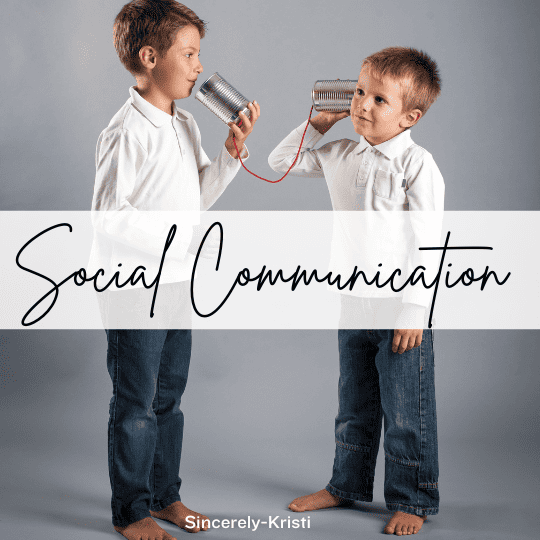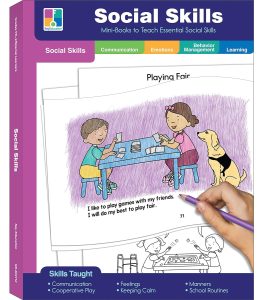Expert Strategies to Build Your Child’s Social Communication Skills

From my experience working as a second grade and Early Intervention Teacher and having raised two children of my own, I can assure you that helping your child build social communication skills will be time and energy well spent. Helping your child build social communication skills is something that will impact them positively across all areas of their life and development.
{This post may contain affiliate links. This means that if you place an order using an affiliate link, I may earn a small amount of compensation at no cost to you.}
One thing I have learned having been married for many years, raising children of my own and working with children and other adults over the years is that effective communication is not something that comes naturally to many people. Even those who are more naturally gifted communicators can benefit from reflecting on how we interact with others and the unspoken messages that we are sending and how they are being received.
Some of the suggestions given below for encouraging social communication skills are for children who have already developed a fair amount of verbal language. If your child is not yet speaking or their communication skills are emerging, read on for some ways to modify further down in the post.
So you want to help your child to improve their communication skills. Where to start?
1. Encourage your child to communicate what they need, rather than merely making statements
Take a look at the following sentences:
I spilled my milk.
I need picked up at 7:00.
I can’t open this jar.
What do they have in common? They are all statements. All of these statements tell you something, but none of them ultimately express the person’s need.

Sound familiar? This is something that would happen with my kids all the time. They would want my help with something, but wouldn’t communicate that with their words. Instead they would simply make a statement. Over time, I stopped automatically assuming for them that they meant one thing when they were in fact saying another thing, or simply failing to complete their request. Instead I starting using these moments as opportunities for them to build their social communication muscles.
In the example, “I spilled my milk.”
- I would offer a prompt, such as, “Do you need help cleaning up the milk?”
- My child would respond, “Yes.”
- I would then prompt, “But you didn’t ask for help, you just told me that it spilled.”
- They would then respond by asking, “Will you help me?” (this can be modeled if needed)
- To which I would respond, “Of course.”
When this would happen, I would point out that I may be able to guess what they needed, but that they weren’t effectively communicating their wants or needs. We can’t, and our kids can’t, expect people to read our minds and anticipate our wants and needs, especially when the situation is over something much bigger than needing to be picked up or help opening a jar.
Over time, my kids got better at saying what they mean. Pay attention to your interactions with others. Do you anticipate others’ needs rather than encouraging them to express themselves clearly? Not only can this become exhausting for the person always expected to anticipate the needs of others, it is also doing a disservice to the people with the need or request. When we do this, they are not being given the opportunity to work on their communication skills. As they grow older, others will be less willing to guess what they want, which can lead to frustration for both parties.
This is not something we are necessarily thinking about when our kids are young, but their future employer, friends, husband or wife may find it rather irritating that their partner has not developed the social skill to just ask for what they need!
Another way to encourage communication skills and confidence is to:
2. Have your children start ordering for themselves at restaurants early and often
We had our kids start ordering their own food at restaurants when they were preschoolers and now we have confident teenagers who aren’t afraid to communicate with workers when out in public.
Here is a great social story to get the conversation started before you head out the door for the restaurant.

Click HERE to order from Amazon
You can help your child to feel successful when ordering their own food at a restaurant by following these tips:
- Help your child pick out their main dish and their side so they are ready when the waiter comes.
- Encourage them to speak loudly and clearly.
- Praise their effort when they order, even if it doesn’t go perfectly.
Provide a Verbal Model
- If your child has emerging language skills or is very shy, you can provide a verbal model for them.
- Providing a verbal model looks like this:
- Parent (to waiter): “I would like…”
- Child repeats (to waiter), ” I would like…”
- Parent: “Chicken strips.”
- Child: “Chicken strips.”
- Parent praises child with a smile and high five.
- The verbal prompt can be faded over time. The next time, the parent can start by saying, “I’d like…” to get the child started and then let the child take over from there. Your child will be ordering on their own before you know it!
- Providing a verbal model looks like this:
Use visual cue cards to support language
- If your child isn’t quite ready to use the verbal model method, you can use visual cue cards. You can print pictures right from your computer, or you can purchase sets for a low cost from Teachers Pay Teachers (you do not need to be a teacher to use this site.)
- Using visual cue cards looks like this:
- You print a couple of pictures of your child’s favorite foods that you know will appear on the menu.
- When at the restaurant, you present 2 or 3 pictures and ask them to point to which they would like.
- When the waiter comes, the parent encourages the child to hold up the card to show the waiter when it is their turn to order.
- Parent praises child with a back pat and a smile (or other positive reinforcement that is meaningful to your child.)
- Using visual cue cards looks like this:
3. Watch social story videos to help prepare your child for an upcoming event
Children absorb a lot of information from what they see and hear going on in the world around them. A great way to help children get practice with social communication skills is by reading social stories or watching social stories on YouTube Kids. YouTube Kids is a safer way for younger viewers as it helps to reduce the chance of them navigating away to inappropriate content.
When working as an Early Intervention Teacher, I often used the social stories from this workbook. The stories are short, there is one for almost any social situation and your child can color them!

Click HERE to order from Amazon
If you’d prefer to watch a social story together and talk about it, here are a few you could try.
***Please preview the video before sharing with your child to make sure that there is no inappropriate content.)
- At the Restaurant Conversation
- Ask for Help Song: Esme and Roy
- Doctor Checkup for Kids
- Sesame Street Learning to Take Turns | Julia and Samuel’s Playdate






